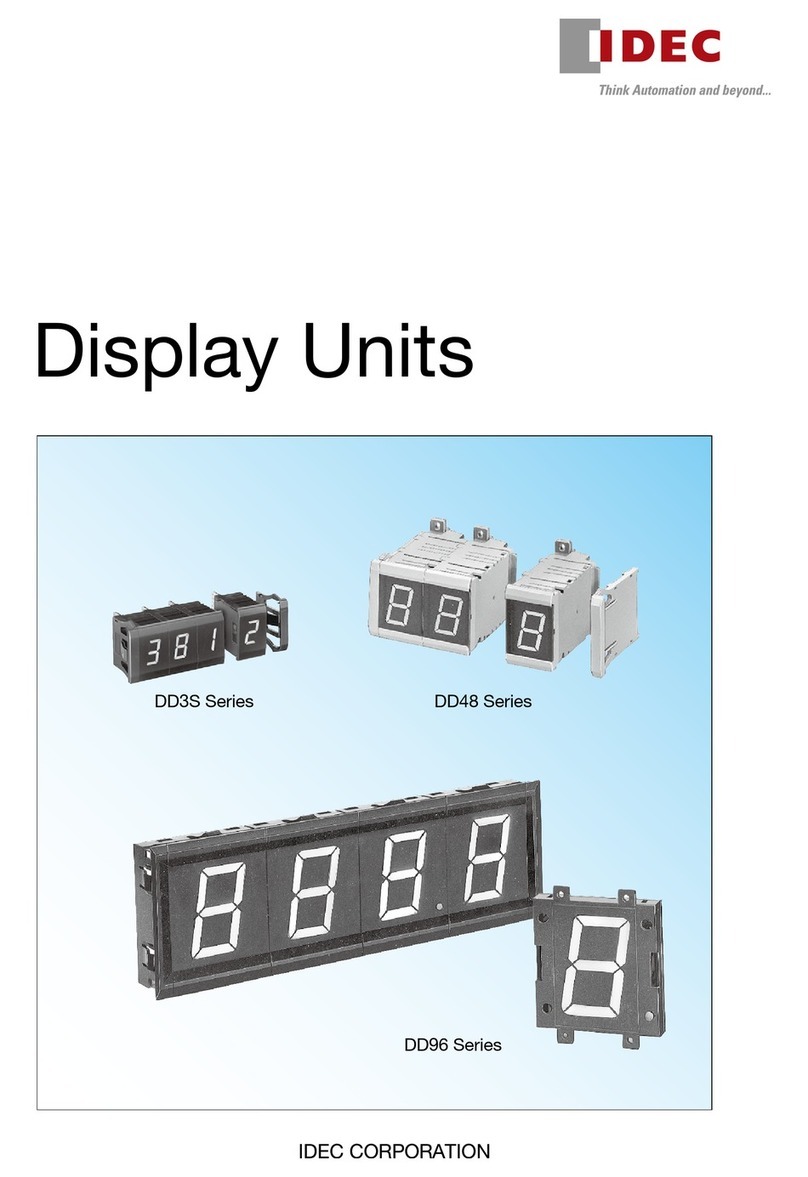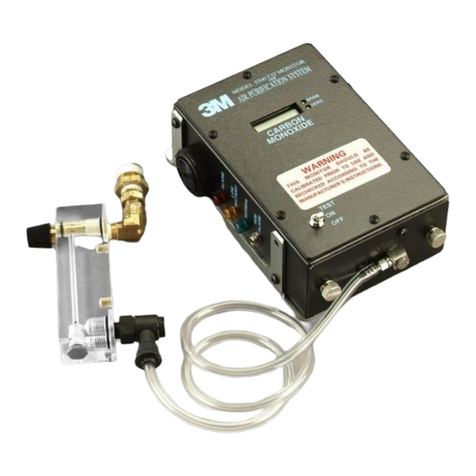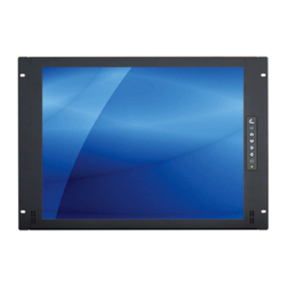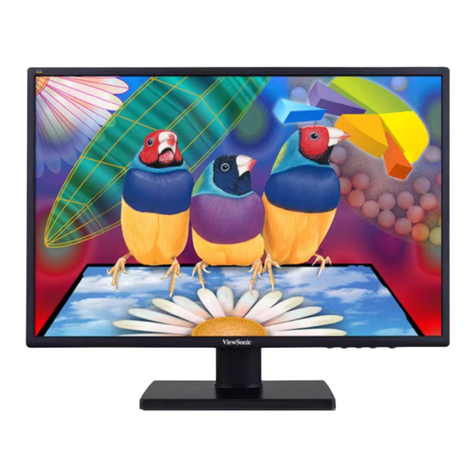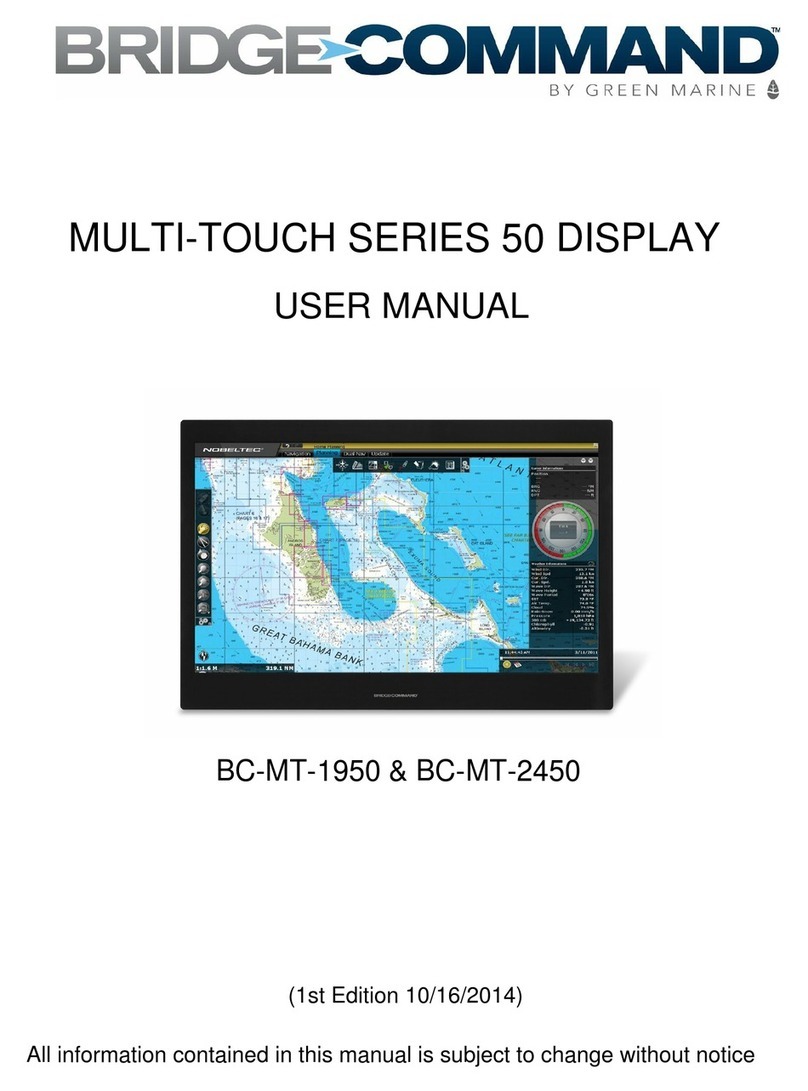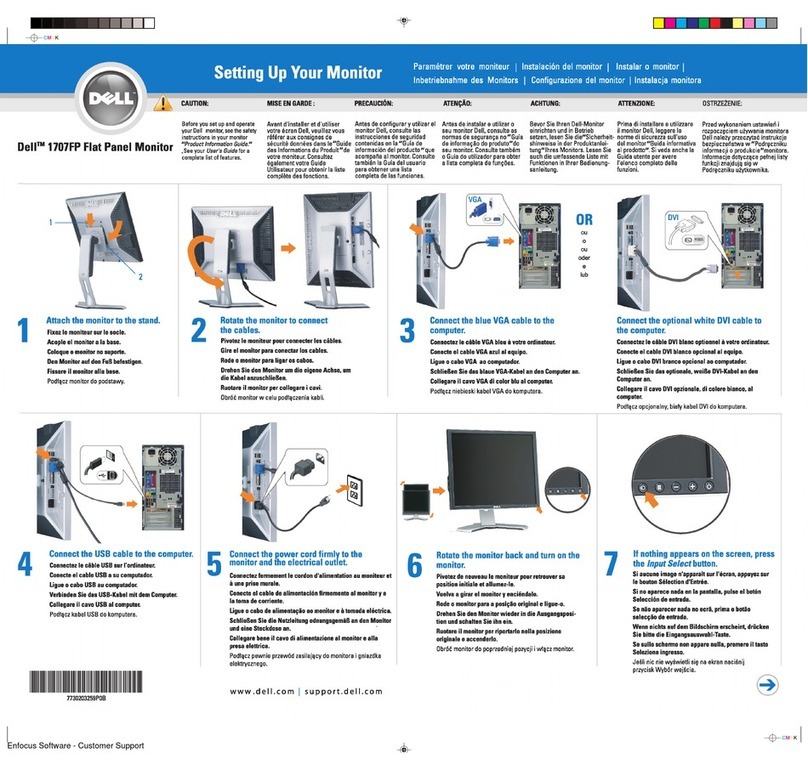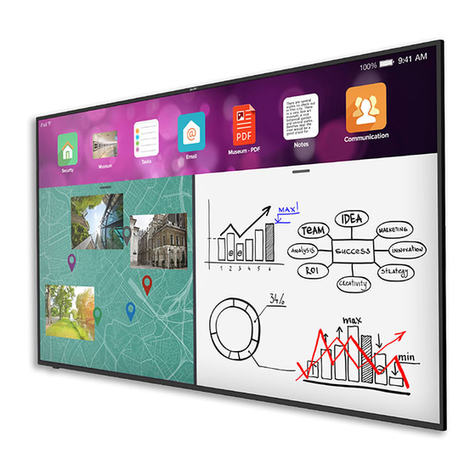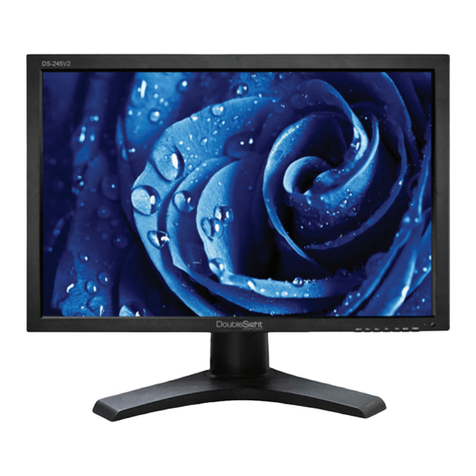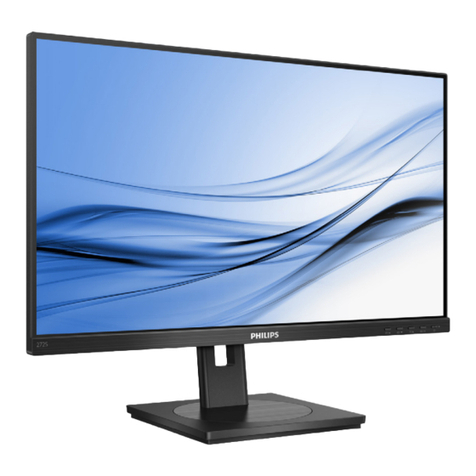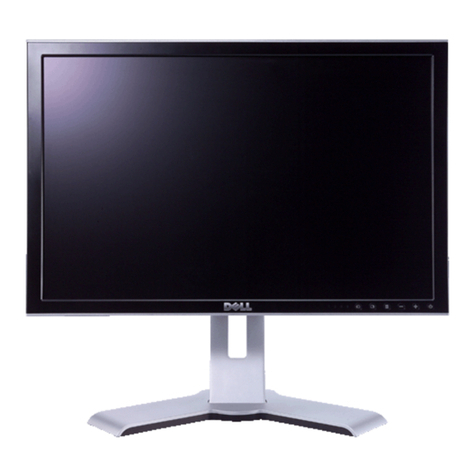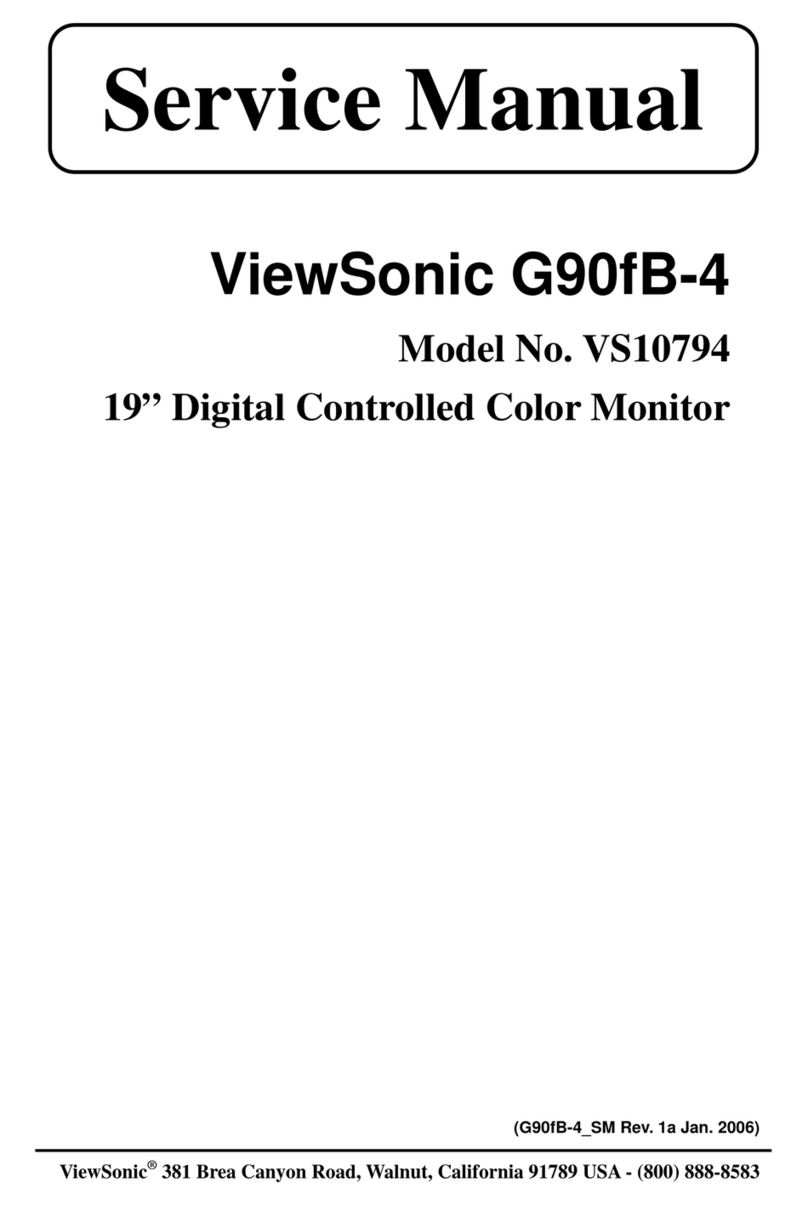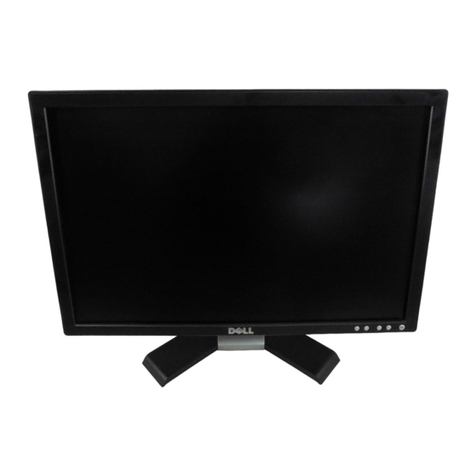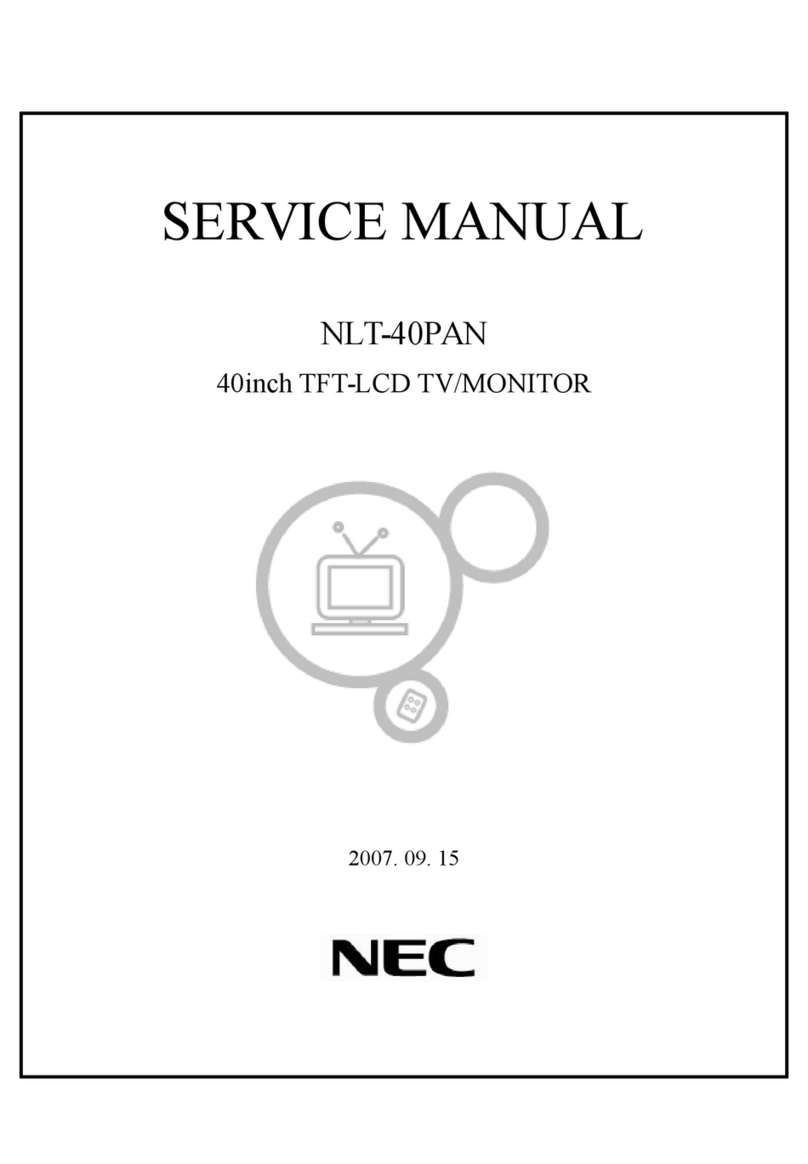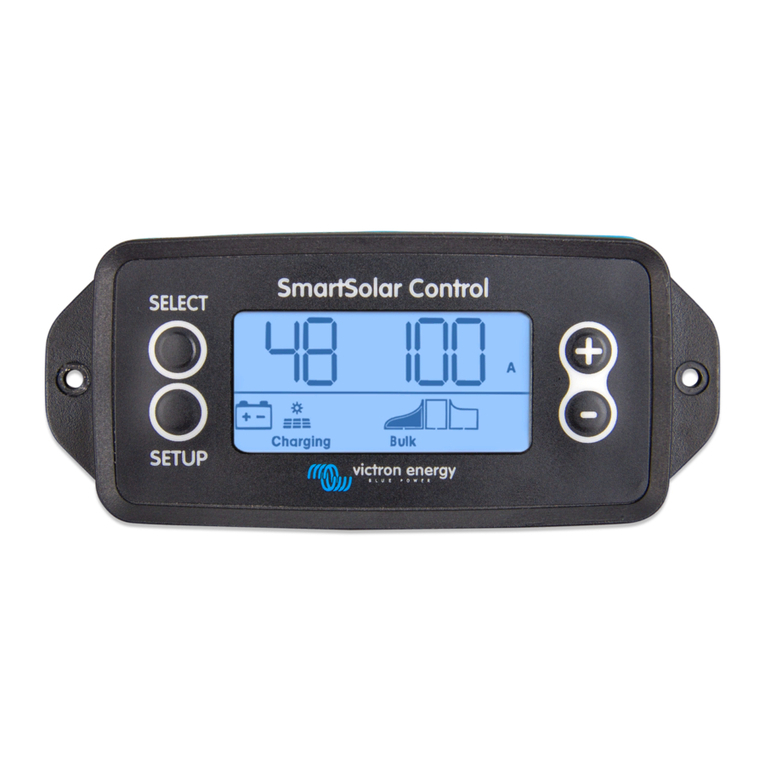IDEC MICRO/I HG2J-7U User manual

MICRO/I HG2J-7U, HG5G/4G/3G/2G-V,
HG4G/3G, HG2G-5F/-5T, HG1G/1P
Hardware Manual
B-2336(0)

SAFETY PRECAUTIONS
Preface-1 MICRO/I Hardware Manual
• Be certain to read this manual carefully before performing installation, wiring, or maintenance work, or operating
the MICRO/I HG2J-7U,HG5G/4G/3G/2G-V, HG4G/3G, HG2G-5F/-5T, HG1G/1P (Hereinafter referred to as
"MICRO/I"). If the MICRO/I is used in a manner not specified by the manufacturer, the protection provided by the
equipment may be impaired.
• The MICRO/I has been manufactured with careful regard to quality. However, if you intend to use this product in
applications where failure of this equipment may result in damage to property or injury, ensure that it used in
conjunction with appropriate fail-safe backup equipment.
• Precautionary measure should be taken to avoid unauthorized access from the outside network to the MICRO/I.
Please note that the Company shall not be liable for any loss, damage or other expenses incurred directly or
indirectly by unauthorized access, etc.
• In this manual, safety precautions are categorized depending on the severity as Warning or Caution:
SAFETY PRECAUTIONS
Warning notices are used to emphasize that improper operation may cause severe
personal injury or death.
Caution notices are used where inattention might cause personal injury or damage to
equipment.
MICRO/I (Common to all models):
• This product is not designed for use in applications requiring a high degree of reliability and safety, such as
applications for medical devices, nuclear power, railroads, aerospace, and automotive devices. This product
should not be used for such applications.
• Turn off the power of this product before installation, removal, wiring, maintenance, and inspection of this
product. Failure to turn power off may cause electrical shock or fire hazard.
• Special expertise is required to install, wire, configure, and operate this product. Person without such expertise
must not use this product.
• This product uses an LCD (liquid crystal display) as a display device. The liquid inside the LCD is harmful to the
skin. If the LCD is broken and the liquid attaches to your skin or clothing, wash the liquid off using soap, and
consult a doctor immediately.
• An emergency circuit that uses emergency stop switch must be configured outside of this product.
• Do not use touch switches, the function keys and selector switches for an emergency circuit or an interlocking
circuit. If this product fails, equipment connected to this product will no longer be protected, and serious injury
to operators and equipment damage may be caused.
• In case this product is accidentally dropped or exposed to significant shock, stop using this product, check this
product for damage, and confirm that its various functions work safely and correctly.
• Connect MICRO/I's FG wire to grounding resistance of 100 Ω or less. Otherwise, there is a risk of electric shock
or malfunction.
• The screen will not be visible if the backlight of this product burns out. However, the touch panel and the function
keys will remain functional. Thus, Erroneous touch panel operation or function key operation may occur while
controlling the touch panel. Because such erroneous operations could result in damage, the touch panel and the
function key should not be used once the backlight is burned out.
HG5G/4G/3G/2G-V, HG4G/3G, HG2G-5F/-5T, HG1G/1P:
• When more than one panel spot is pressed at the same time, due to the detection mechanism of the analog type
touch panel used in this product, the unit assumes that only the center of the pressed spots is sensed and the unit
assumes that only one button is pressed. Therefore, do not operate this product by pressing more than one button
simultaneously.

MICRO/I Hardware Manual Preface-2
SAFETY PRECAUTIONS
HG1P:
• For the emergency stop switch and the enabling switch on this product, note the following points:
- Connect the emergency stop switch to function as either a category 0 or category 1 stop in accordance with EN 60204-1.
- Perform regular checks to confirm that the emergency stop switch and enabling switch work properly. It is extremely
dangerous if the enabling switch no longer returns to position 1 due to a foreign object getting stuck in the switch.
- Do not, under any circumstances, hold the enabling switch in position 2 with tape, string, or deform the rubber
cover. The function of the enabling switch will be lost, and the enabling switch may not work in an emergency.
- Place your finger firmly on the enabling switch.
• The emergency stop function is disabled when main unit is removed from the machine. To eliminate the
possibility of accidents caused by operating the disabled emergency stop switch, place this product, removed
from the machine, in a location that is not visible to the operator. Install at least one emergency stop switch on
the machine near the location where the HG1P is connected.
MICRO/I (Common to all models):
• Prevent this product from falling while moving or transporting, otherwise it may cause damage or malfunction to
this product as a result.
• Use the product within the environmental limits given in the catalog and this manual. Use of the product in high-
temperature or high-humidity environments, or in locations where it is exposed to condensation, corrosive gas,
or large shock loads can create the risk of electrocution and fire.
• This product is designed for use in pollution degree 2. Use this product in environments of pollution degree 2.
(based on the IEC 60664-1 rating)
• Install this product according to this manual. Improper installation will result in falling, failure, electrical shock,
fire hazard, or malfunction of this product.
• Prevent metal fragments or wire chips from dropping inside this product housing. Ingress of such fragments and
chips may cause fire hazard, damage, and malfunction.
• Use a power supply of the rated value. Using a wrong power supply may cause fire hazard.
• When exporting this product to Europe, use an EN 60127 (IEC 60127) approved fuse on the power line outside
this product.
• When exporting this product to Europe, use an EU-approved circuit protector.
• Make sure of safety before starting and stopping this product. Incorrect operation of this product may cause
mechanical damage or accidents.
• This product cannot be directly connected to the communication lines (including public wireless LAN) of
telecommunication carriers (mobile communication companies, fixed-line communication companies, Internet
providers, etc.). When connecting this product to the Internet, be sure to connect via a device, such as a router.
• The touch panel of this product is made of glass, and will break if exposed to excessive shock. Take due care
when handling it.
• The protective film attached to the display of this product is to protect the product from scratches during
transportation. Please remove the protective film before use. If the display is used with protective film, the film
may become cloudy and stick to the display depending on the usage environment and may become unremovable.
• Do not push hard or scratch the touch panel and protection sheet with a hard object like hand tool. Touch panel
and protection sheet can be easily damaged.
• Do not install this product in areas subjected to strong ultraviolet rays, since ultraviolet rays may impair the
quality of the LCD.
• Do not attempt to disassemble, repair or modify this product. This can create the risk of fire or electrocution.
• When disposing of this product, do so as an industrial waste.
• When using this product in a system that requires clock accuracy, set the time regularly.
• Do not switch off the power or pull out the SD Memory Card or the USB flash drive while it is being accessed, as
this may result in destruction of the stored data. If the data on the SD Memory Card or the USB flash drive is
corrupted, format the SD Memory Card or the USB flash drive.
• Turn off the power supply of this product before connecting or disconnecting USB devices other than USB memory.

Revision history
Preface-3 MICRO/I Hardware Manual
Revision history
Caution
• All rights in this manual belong to IDEC Corporation. It may not be reproduced, reprinted, sold, transferred or
rented without our permission.
• The contents of this manual are subject to change without notice.
• Please contact your vendor or IDEC Corporation with any problems regarding the operation of this product.
Trademarks
WindO/I and MICRO/I are registered trademarks of IDEC CORPORATION in JAPAN.
All other company names and product names used in this manual are trademarks of their respective owners.
HG2J-7U:
• This product uses “PS2” as DC power supply. (based on the IEC/EN 61131 rating)
• Use wire of a proper size to meet the voltage and current requirements.
HG5G/4G/3G/2G-V, HG4G/3G, HG2G-5F/-5T, HG1G:
• This product “PS2” as DC power supply. (based on the IEC/EN 61131 rating)
• Use wire of a proper size to meet the voltage and current requirements, and tighten the terminal screws of this
product to the specified tightening torque.
HG5G/4G/3G/2G-V, HG4G/3G, HG2G-5F:
• Be sure to confirm that the SD Memory Card Access lamp is not lit prior to turning the power off to this product
or pulling out the SD memory card. Refer to this manual for details.
HG1P:
• Use the HG1P optional cable for proper wiring.
• The D-sub connector on the end of the HG1P optional cable is not water- or dust-proof. If protection against
water and dust is required, the user must replace the D-sub connector with a water-proof connector.
September 2023: First Edition

MICRO/I Hardware Manual Preface-4
Preface
Preface
Thank you for purchasing the MICRO/I manufactured by IDEC Corporation.
This manual describes the specifications of MICRO/I HG2J-7U, HG5G/4G/3G/2G-V, HG4G/3G, HG2G-5F/-5T, HG1G/1P,
how to install it, and various functions.
Read this manual to ensure the correct understanding of the entire functions of this product.
IDEC Corporation makes the latest product manual PDFs available on our website at no additional cost. Please
download the latest product manual PDFs from our website.
Read the following materials as necessary for your particular application.
References Content
MICRO/I Hardware Manual
(This document)
Describes the product specifications, installation and wiring methods,
maintenance and inspection of the HG2J-7U, HG5G/4G/3G/2G-V, HG4G/3G,
HG2G-5F/-5T and HG1G/1P.
WindO/I-NV4 User's Manual (PDF)
Describes the basic operations of the HG2J-7U, HG5G/4G/3G/2G-V, HG4G/3G,
HG2G-5F/-5T and HG1G/1P, how to create the project necessary for operation,
and the various drawings and parts that make up the project.
WindO/I-NV4 External Device Setup
Manual (PDF)
Describes the connection procedures and available device addresses for various
communication including the Device Link Communication, O/I Link
communication, and DM Link communication.

Symbols Used in this Manual
Preface-5 MICRO/I Hardware Manual
Symbols Used in this Manual
This manual uses the following symbols to facilitate explanation.
Symbols
…… Information that requires special attention. Failure to operate the product in accordance with the
information provided can lead to serious injury or damage.
…… Information relating to requests or material to reference in the use of a function
…… Useful information relating to a function
OK …… Screen buttons are indicated by bold text or by using the actual graphic icon.
**** …… Controls are indicated by bold text.

MICRO/I Hardware Manual Preface-6
Abbreviations, Generic Terms, and Terminology Used in this Manual
Abbreviations, Generic Terms, and Terminology Used in this Manual
Item Description
HG2J-7U The name is short for MICRO/I HG2J-7UT22TF-B.
HG5G-V The name is short for MICRO/I HG5G-VFXT22MF-B.
HG4G-V The name is short for MICRO/I HG4G-VCXT22MF-B.
HG4G The name is short for MICRO/I HG4G-CJT22*F-B.
HG3G-V The name is short for MICRO/I HG3G-V*XT22MF-*.
HG3G The name is short for MICRO/I HG3G-*JT22*F-*.
HG2G-V The name is short for MICRO/I HG2G-V5FT22TF-*.
HG2G-5F The name is short for MICRO/I HG2G-5FT22TF-*.
HG2G-5T The name is short for MICRO/I HG2G-5T*22TF-*.
HG1G The name is short for MICRO/I HG1G-4VT22TF-*.
HG1P The name is short for MICRO/I HG1P-ST32*.
HG5G/4G/3G/2G-V The format used to refer to HG5G-V, HG4G-V, HG3G-V and HG2G-V.
HG5G/4G/3G-V The format used to refer to HG5G-V, HG4G-V and HG3G-V.
HG4G/3G The format used to refer to HG4G and HG3G. HG4G-V and HG3G-V is not included.
HG2G-5F/-5T The format used to refer to HG2G-5F and HG2G-5T.
HG1G/1P The format used to refer to HG1G and HG1P.
MICRO/I Generic term used to refer to the HG2J-7U, HG5G/4G/3G/2G-V, HG4G/3G, HG2G-5F/-5T,
HG1G/1P.
External Device Generic term used to refer to a PLC or micro computer that is connected to and
communicates with the main unit.
Device Address Memory that is capable of storing values in unit of bits or words loaded on the main unit
and external device.
User Communication A communication method which performs communication with external devices such as
barcode readers and inverters.
WindO/I-NV4 Integrated configuration software application for creating projects of the main unit.
Operating System Software used to manage and control system software. Only HG2J-7U supports the update.
System Software Software that performs basic control and management of the main unit.
Project Data including image data required for operating the main unit, which is created with
WindO/I-NV4.
Setup Generic term used to refer to the common settings in the project.
Script A function that can describe complex calculations and operations in text.
Internal Device The generic term for internal device addressing on the main unit such as internal relays,
registers, etc.
Parts Define as functional content (i.e. button, pilot lamp, commands, etc.)

Contents
Preface-7 MICRO/I Hardware Manual
SAFETY PRECAUTIONS .................................................................................Preface-1
Revision history ............................................................................................Preface-3
Caution........................................................................................................Preface-3
Trademarks..................................................................................................Preface-3
Preface ........................................................................................................Preface-4
Symbols Used in this Manual .........................................................................Preface-5
Abbreviations, Generic Terms, and Terminology Used in this Manual ................Preface-6
Chapter 1 Main Unit Specifications
1 HG2J-7U ...............................................................................................................1-1
1.1 Packing Content ............................................................................................. 1-1
1.2 Type Number................................................................................................. 1-1
1.3 Part Names.................................................................................................... 1-2
1.4 External Interfaces ......................................................................................... 1-3
1.5 Specifications................................................................................................. 1-5
1.6 Dimensions.................................................................................................... 1-8
1.7 Installation .................................................................................................... 1-9
1.8 Wiring ..........................................................................................................1-12
1.9 Maintenance and Inspection...........................................................................1-14
1.10 Software License Information.........................................................................1-15
2 HG5G/4G/3G/2G-V ..............................................................................................1-16
2.1 Packing Content ............................................................................................1-16
2.2 Type Number................................................................................................1-17
2.3 Part Names...................................................................................................1-17
2.4 External Interfaces ........................................................................................1-20
2.5 Specifications................................................................................................1-22
2.6 Dimensions...................................................................................................1-25
2.7 Installation ...................................................................................................1-30
2.8 Wiring ..........................................................................................................1-33
2.9 USB Cable Lock Pin Attachment......................................................................1-34
2.10 Maintenance and Inspection...........................................................................1-35
3 HG4G/3G, HG2G-5F .............................................................................................1-39
3.1 Packing Content ............................................................................................1-39
3.2 Type Number................................................................................................1-40
3.3 Part Names...................................................................................................1-41
3.4 External Interfaces ........................................................................................1-43
3.5 Specifications................................................................................................1-45
3.6 Dimensions...................................................................................................1-47
3.7 Installation ...................................................................................................1-51
3.8 Wiring ..........................................................................................................1-54
3.9 USB Cable Lock Pin Attachment......................................................................1-55
3.10 Maintenance and Inspection...........................................................................1-56
Contents

Contents
MICRO/I Hardware Manual Preface-8
4 HG2G-5T, HG1G ................................................................................................. 1-60
4.1 Packing Content............................................................................................ 1-60
4.2 Type Number................................................................................................1-61
4.3 Part Names...................................................................................................1-61
4.4 External Interfaces........................................................................................1-63
4.5 Specifications................................................................................................1-65
4.6 Dimensions...................................................................................................1-68
4.7 Installation ...................................................................................................1-70
4.8 Wiring ..........................................................................................................1-72
4.9 USB Cable Lock Pin Attachment......................................................................1-73
4.10 Maintenance and Inspection .......................................................................... 1-74
5 HG1P ................................................................................................................. 1-79
5.1 Packing Content............................................................................................ 1-79
5.2 Type Number................................................................................................1-79
5.3 Part Names...................................................................................................1-80
5.4 External Interfaces........................................................................................1-81
5.5 Specifications................................................................................................1-82
5.6 Dimensions...................................................................................................1-89
5.7 Installation ...................................................................................................1-90
5.8 Wiring ..........................................................................................................1-93
5.9 Maintenance and Inspection .......................................................................... 1-95
Chapter 2 Expansion Modules
1 Overview.............................................................................................................. 2-1
1.1 Overview of Expansion Modules .......................................................................2-1
1.2 Applicable Expansion Modules..........................................................................2-2
1.3 The Expansion Module Operation .....................................................................2-7
2 Analog I/O Modules ............................................................................................ 2-13
2.1 Using Analog I/O Modules..............................................................................2-13
2.2 Analog I/O Module Parameter Settings ...........................................................2-13
2.3 Device Allocation...........................................................................................2-26
3 Digital I/O Modules ............................................................................................. 2-30
3.1 Using Digital I/O Modules ..............................................................................2-30
Chapter 3 Options
1 Optional items ...................................................................................................... 3-1
1.1 HG2J-7U.........................................................................................................3-1
1.2 HG5G/4G/3G/2G-V ..........................................................................................3-2
1.3 HG4G/3G, HG2G-5F.........................................................................................3-4
1.4 HG2G-5T, HG1G..............................................................................................3-6
1.5 HG1P .............................................................................................................3-7
2 Replacement Parts ................................................................................................ 3-9
2.1 HG2J-7U.........................................................................................................3-9
2.2 HG5G/4G/3G/2G-V ..........................................................................................3-9
2.3 HG4G/3G, HG2G-5F.........................................................................................3-9
2.4 HG2G-5T, HG1G............................................................................................3-10
2.5 HG1P ...........................................................................................................3-10

Contents
Preface-9 MICRO/I Hardware Manual

MICRO/I Hardware Manual 1-1
1
Main Unit Specifications
1.1 Packing Content
Before installing the HG2J-7U, make sure that the model you have received is what you actually ordered, and no parts
are damaged to accidents during shipping.
1.2 Type Number
Chapter 1 Main Unit Specifications
1 HG2J-7U
Product Name & Appearance Quantity Description
HG2J-7U
1 Main unit
Mounting clip
4 -
Serial interface connector
1 Removable terminal block 9-pin
LCD Bezel Color Type Number
7.0 inch wide TFT Color Black HG2J-7UT22TF-B

1 HG2J-7U
1-2 MICRO/I Hardware Manual
1.3 Part Names
No. Name Description
(1) POWER LED
Green (lit): Normal Operation
Green (flash): Operating system is booting. (Normal Operation)
Orange (lit): Operating system is booting. (Boot mode)
Orange (flash): Preparing to boot the operating system, running in boot mode.
Red (lit): Main unit is damaged.
Not lit : Power is off.
(2) Display TFT color LCD
(3) Touch Panel PCAP touchscreen (Projected capacitive)
(4) Serial Interface (COM)
RS232C, RS422/485
Connector: Terminal Block 9-pin (Push-in type)
Maximum cable length: 15m (RS232C), 1200m (RS422/485)
(5) USB Interface (USB1)
USB2.0 (Host)
Connector: Type-A
Output current: 5V 500mA
(6) USB Interface (USB2)
USB2.0 (Host)
Connector: Type-A
Output current: 5V 500mA
(7) Ethernet Interface (LAN)
IEEE802.3u 10BASE-T/100BASE-TX
Connector: RJ-45(With Auto MDI/MDI-X function)
Maximum cable length: 100m
(8) Power Supply Terminal Connector: Terminal Block 3-pin (Push-in type)
(9) Mounting Clip Position 4 places
(10) RESET Switch -
(1)
(7)
(2) (3)
(8)
(5)
(6)
(10)
(9)
(4)

MICRO/I Hardware Manual 1-3
1 HG2J-7U
1
Main Unit Specifications
1.4 External Interfaces
●Serial Interface (COM)
Use applicable cables for wiring and recommended ferrules (made by IDEC, Phoenix Contact or Weidmüller) as
follows.
• Make sure to turn off the power to the HG2J-7U before wiring each interface.
• The serial interface (COM) can be used as the RS232C and RS422/485 interfaces at same time.
• Use the SELV (Safety Extra-Low Voltage) circuit to connect each interface.
Interface Specification RS232C, RS422/485
Connector Detachable Terminal Block 9-pin
Applicable cable AWG16 to 28
Conductor Type Solid wire or Stranded wire
Wire Strip Length*1 8 to 9 mm
Recommended ferrule
ST3L-H025-12WJ
S3TL-H034-12WT
S3TL-H05-14WA
S3TL-H075-14WW
(IDEC)
AI 0,25-8YE
AI 0,34-8TQ
AI 0,5-8WH
AI 0,75-8GY
(Phoenix Contact)
H0,25/12 HBL
H0,34/12 TK
H0,5/14 OR
H0,75/14 W
(Weidmüller)
*1 Strip the sheath of the wire 8 to 9 mm from the end.
No. Name I/O Function Communication type
1 SD OUT Send Data
RS232C
2 RD IN Receive Data
3 RS OUT Request to Send
4 CS IN Clear to Send
5 SG ― Signal Ground
RS422/485
6 SDA OUT Send Data (+)
7 SDB OUT Send Data (-)
8 RDA IN Receive Data (+)
9 RDB IN Receive Data (-)
8 to 9 mm
No.1 No.9
Only one ferrule can be inserted into a terminal hole.
Please set another terminal block in the vicinity of the main unit and connect SG when using RS232C and
RS422/485 requiring crossover wiring at the same time. And separate the communication cables so that
they do not affect each communication waveform when using RS232C and RS422/485 at the same time.

1 HG2J-7U
1-4 MICRO/I Hardware Manual
Using RS422/485 interface
HG2J-7U is not equipped with terminating resistor. Insert a terminating resistor of an appropriate value (about 100 to
120 Ohm, 1/2 W minimum) between terminal number 8 (RDA) and terminal number 9 (RDB), if necessary.
For details about inserting and removing wires, refer to “1.8 Wiring” on page 1-12.
Terminal Number 8 (RDA) Terminal Number 9 (RDB)

MICRO/I Hardware Manual 1-5
1 HG2J-7U
1
Main Unit Specifications
1.5 Specifications
■Applicable Standards
■Environmental Specifications
■Electrical Specifications
■Construction Specifications
Safety Standards
UL61010-1, UL61010-2-201, UL121201
CSA C22.2 No.61010-1-12 (c-UL), CSA C22.2 No.61010-2-201 (c-UL),
CSA C22.2 No.213 (c-UL)
EMC Standards IEC/EN 61131-2
Ambient Operating Temperature -20 to +60°C*1 (no freezing)
Ambient Operating Humidity 10 to 90% RH (no condensation)
Ambient Storage Temperature -20 to +70°C (no freezing)
Ambient Storage Humidity 10 to 90% RH (no condensation)
Altitude 0 to 2000m
Pollution Degree 2
Corrosion Immunity Free from corrosive gases
*1 For details about the output current limitation of the USB interface due to the ambient operating temperature, refer to
“Restrictions due to mounting orientation” on page 1-11.
Rated Voltage 12V/24V DC
Power Consumption 13W maximum
Not using USB Interface (USB1, USB2) 5W maximum
Backlight OFF 3W maximum
Power Voltage Range 10.2 to 28.8V DC
Allowable Momentary Power Interruption 10 ms maximum (Power supply: 20.4 to 28.8V DC)
1 ms maximum (Power supply: 10.2 to 20.4V DC)
Inrush Current 40A maximum
Dielectric Withstand Voltage AC500V, 10mA, 1 minute (between power and earth terminals)
Vibration Resistance
5 to 8.4Hz amplitude 3.5mm,
8.4 to 150Hz acceleration 9.8m/s2
10 times on each of three mutually perpendicular axes
(IEC 61131-2)
Shock Resistance 147m/s2, 11ms (3 shocks on each of three mutually perpendicular axes)
(IEC 61131-2)

1 HG2J-7U
1-6 MICRO/I Hardware Manual
■Performance Specifications
Display
LCD Type*1 TFT color LCD (TN Type)
Display Colors 65,536 Colors
Effective Display Area 154.08 (W) × 85.92 (H) mm
Display Resolution 800 (W) × 480 (H) dots
Dot pitch 0.1926 (W) x 0.179 (H) mm
View angle Left/Right/Top: 80°, Bottom: 60°
Brightness of LCD only 500 cd/m2
Brightness Adjustment 48 levels
Backlight LED (white)
Backlight Life*2 Approx. 50,000 hours (The time until brightness becomes 50% of the initial value)
Touch
Panel
Switch Type Projected Capacitive
Multiple Operations Possible (2-point touch)
User Memory Approx. 24 MB
Backup time of the real-time
clock (Ambient Operating
Temperature at 25°C)
Min. 20 days*4
Backup Data Calendar, Log Data, HMI Keep Relays, HMI Keep Registers
Buzzer output Single tone (tone length is adjustable)
Degree of Protection*3
Panel thickness is 1 mm or more and less than 1.6 mm: IP65F IEC 60529)
Panel thickness is 1.6 mm or more and 5 mm or less: IP66F, IP67F (IEC 60529),
TYPE 4X (indoor use only),
TYPE 13
Weight (approx.) 500g
*1 Please be aware that small black and bright dots might show up on LCD Screen: it is not a failure or malfunction.
*2 The life of the LCD itself at an ambient temperature of 25°C. This is not a guaranteed value. The actual life depends on the
environment and conditions of use.
*3 It is a protection structure for the operating surface of HMI, which is attached to a panel. Although protection structure
suffices every test conditions, it does not guarantee to operate under all of the environmental condition. As for IP65F/IP66F/
IP67F oilproof structure, it suffices oilproof test conditions. Conditions are listed in the document that comes with Japanese
Industrial Standard JIS C 0920. Protection structure do not guarantee usage under long exposure to oil or usage of oil that
is not prescribed in the document. Please test/check beforehand to avoid trouble. IP ratings are not applicable to UL
certification.
*4 If the power interruption period exceeds the Backup time of the real-time clock, the error message "Initialize clock data" will
be displayed when the power is turned on, and the clock data will be initialized to 00:00:00 on January 1, 2000.

MICRO/I Hardware Manual 1-7
1 HG2J-7U
1
Main Unit Specifications
■EMC Specifications
Radiated Emission
Class A: 10m
40dBµV/m quasi-peak (30M to 230MHz)
47dBµV/m quasi-peak (230M to 1GHz)
Class A: 3m
76dBµV/m (Peak), 56dBµV/m (AVG) (1G to 3GHz)
80dBµV/m (Peak), 60dBµV/m (AVG) (3G to 6GHz)
Electrostatic Discharge Contact: ±6kV
Air: ±8kV
Electromagnetic Field
10V/m (80M to 1000MHz)
3V/m (1.4G to 2.0GHz)
3V/m (2.0G to 2.7GHz)
3V/m (2.7G to 6.0GHz)
80% AM (1kHz)
Fast Transient/Burst Power: ±2kV
Communication cable: ±1kV
Surge Immunity ±500V (between +24V and 0V)
±500V (between +24V and FE, 0 and FE)
Conducted Radio
Frequency Immunity
3V (Power, Communication cable) (150k to 80MHz)
80% AM (1kHz)

1 HG2J-7U
1-8 MICRO/I Hardware Manual
1.6 Dimensions
Unit: mm
<Cable Attached Dimensions>
Depending on the type of connection cable used the dimensions shown above will change. The dimensions given here
are representative values and are intended for reference only.
186.0
128.0
176.2
6.024.4
28.3
118.2
56 176.2
15 118.2

MICRO/I Hardware Manual 1-9
1 HG2J-7U
1
Main Unit Specifications
●About the printed contents of the main unit
"Mark A" indicates that you can refer to the instruction sheet using the QR code. For details, refer to “1.8 Wiring” on
page 1-12.
1.7 Installation
●Operating Environment
For designed performance and safety of the HG2J-7U, do not install the HG2J-7U in the following environments:
• Where dust, briny air, or iron powder exist.
• Where oil or chemical splashes for a long time.
• Where space is filled with oil mist.
• Where direct sunlight falls on the main unit.
• Where strong ultraviolet rays fall on the main unit.
• Where corrosive or combustible gasses exist.
• Where shocks or vibrations are transmitted.
• Where condensation occurs due to rapid temperature change.
• Where high-voltage or arc-generating equipment (electromagnetic contactors or circuit protectors) exists in close
proximity.
●Ambient Temperature
• Allow sufficient space for ventilation, and install the equipment away from heat sources.
• Allow at least 100mm between the HG2J-7U and walls or other equipment.
• Do not install the HG2J-7U where the ambient temperature exceeds the rated operating ambient temperature
range. When mounting the HG2J-7U in such locations, provide a forced air-cooling fan or air-conditioner to keep
the ambient temperature within the rated temperature range.
• The HG2J-7U is designed to install on a vertical plane so that natural air-cooling is provided. If you install it using
any other orientation, use forced-air cooling, or lower the ambient operating temperature.
●About Derating
HG2J-7U suppresses the temperature rise inside the product by reducing the backlight brightness when the ambient
operating temperature becomes high.
The relationship between ambient operating temperature and brightness when the USB interfaces (USB1 and USB2)
are not used is as follows.
Brightness reduction occurs depending on the output current value of the USB interface.
Depending on each product the values shown above will change. The values given here are representative values are
intended for reference only.
See instr.
Manual.
<QR code>
Mark A
Ambient Operating Temperature
60℃55℃-20℃
20%
0%
Brightness
100%

1 HG2J-7U
1-10 MICRO/I Hardware Manual
●Installation
• Make a panel cut-out on the panel with the dimensions shown below.
• Use the attached mounting clips to tighten the screws evenly to mount panel: screws must be applied on total of
four places with the specified torque 0.5 to 0.6N∙m.
• Mount the main unit on a rigid panel.
• Do not tighten with excessive force, otherwise the main unit may warp the display, or impair the waterproof
characteristics.
• If the mounting clips are tightened obliquely to the panel, the main unit may fall off the panel.
• When installing the main unit into a panel cut-out, make sure that the gasket is not twisted. Especially when re-
installing, take special care because any twists in the gasket will impair the waterproof characteristics. Also, if
the gasket comes off the main unit, align the convex part of the gasket with the concave part of the front case,
and then insert the gasket fully into the gasket mounting groove without twisting it.
Unit: mm
A B Panel Thickness
118.6 +1.0
0 176.6 +1.0
0 1.0 to 5.0
B
A
Panel
Mounting Clip
Mounting Clip
This manual suits for next models
7
Table of contents
Other IDEC Monitor manuals
